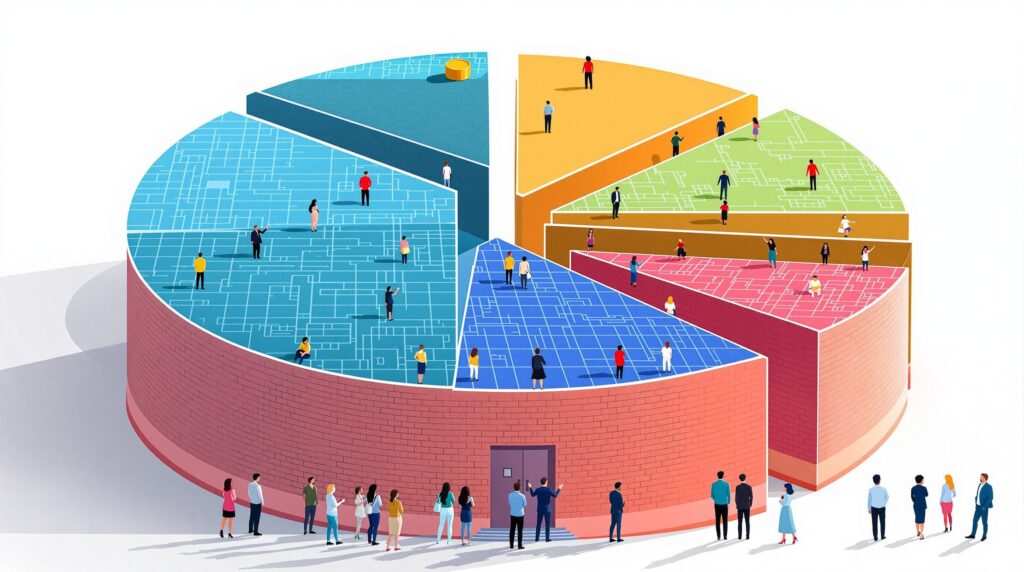[rev_slider alias=”slider-1″][/rev_slider]
Understanding Layer 1 Blockchain Solutions: The Backbone of Decentralization
What is Layer 1 Blockchain Technology? Layer 1 blockchain refers to the base network, such as Bitcoin or Ethereum, and the underlying architecture that creates the foundation for the entire ecosystem, handling and verifying transactions independently.
Layer 1 blockchain technology forms the cornerstone of the blockchain universe, acting as the foundation upon which Layer 2 solutions and various dApps are built. These solutions are like the bedrock for decentralized platforms, allowing for the creation, processing, and security of digital currency and assets without relying on intermediaries. You might think of Layer 1 technology as the primary, standalone blockchain upon which other networks and protocols are developed.
- Bitcoin: Often hailed as the first and most prominent Layer 1 blockchain, Bitcoin introduced the world to decentralized currency and immutable digital records. Its simplicity and robust security make it a stalwart in the blockchain community.
- Ethereum: While Ethereum offers the foundational blockchain like Bitcoin, its primary contribution is the introduction of smart contracts, allowing complex automated functions and leading to a boom in decentralized applications (dApps).
- Cardano: Known for its scientific approach, Cardano emphasizes sustainability and interoperability, providing a scholarly-backed foundation to blockchain innovations.
“Ethereum’s smart contracts propelled blockchain technology beyond currency, introducing a platform for decentralized applications and financial autonomy.”
Layer 1 solutions inherently enhance decentralization primarily by removing the dependency on third parties for transaction verification and settlement. This ensures that the system remains open, transparent, and resistant to censorship or manipulation. In countries across Africa, where financial exclusion is a significant issue, Layer 1 technologies can bridge gaps by providing secure and accessible financial systems.
One of the key benefits of Layer 1 blockchains is their role in decentralization. By handling all transactions and data on a peer-to-peer basis, these systems reduce the risks associated with centralized control, limiting the potential for monopolistic practices and ensuring that power remains distributed among all network participants.
As layer 1 blockchains like Bitcoin and Ethereum progress, they continually refine their protocols to increase efficiency, scalability, and security. They serve as the spine of more complex ecosystems, offering foundations upon which innovations like Layer 2 scaling solutions develop, fostering an inclusive digital economy that’s accessible and beneficial to all, including thriving markets in Africa.
Layer 1 blockchains empower individuals by ensuring equitable network participation, thereby nurturing decentralized finance (DeFi) solutions and democratizing financial access.
It’s fascinating how Layer 1 blockchains have empowered projects across Africa. For instance, Jara is utilizing these robust technologies to bolster the African digital asset economy. By integrating with $JARA’s ecosystem, built on Layer 2 blockchain solutions, individuals can access a wide variety of financial services designed for the decentralized age.
In summary, Layer 1 blockchain solutions provide the vital infrastructure needed for the widespread adoption of decentralized technologies, ensuring secure, efficient, and open financial systems. This foundation is critical as we move towards a future where digital currencies and decentralized networks become integral components of global and local economies alike.
Exploring Layer 2 Solutions: Enhancing Blockchain Scalability
- Introduction to Layer 2 blockchain solutions: Have you ever wondered how blockchain networks manage to handle vast amounts of transactions? That’s where Layer 2 solutions come in. Layer 2 refers to secondary frameworks or protocols built on top of the existing blockchain (Layer 1) to improve its functionality, primarily by enhancing scalability. In simple terms, while Layer 1 focuses on security and decentralization, Layer 2 is tasked with bringing speed and efficiency to the table.
- Impact of Layer 2 solutions on network efficiency: Layer 2 solutions play a pivotal role in enhancing network efficiency by offloading transactions from the Layer 1 main chain. This not only results in faster transaction times but also drastically lowers transaction fees. Could this be the secret sauce to making blockchain accessible to everyone? By alleviating congestion on the main network, Layer 2 solutions allow for a more seamless user experience that’s akin to using traditional digital payment systems.
Why are Layer 2 solutions essential? They significantly boost blockchain scalability by processing transactions off-chain, reducing load on the primary network while maintaining security.
Comparison between Layer 1 and Layer 2 in terms of scalability
When discussing blockchain technology, it’s crucial to understand the scalability challenges faced by Layer 1 and how Layer 2 addresses them. Layer 1 blockchains establish the foundational security and decentralization needed for blockchain integrity but often suffer from slow transaction speeds and high costs due to their very structure.
On the other hand, Layer 2 offers a robust solution by effectively taking on the transaction burden, allowing Layer 1 to focus solely on network security. This is accomplished through various methods, including state channels, sidechains, and rollups. These methods ensure that while the core blockchain maintains its security and decentralization, its usability and reach can expand dramatically. Isn’t this innovation essential for creating a more inclusive digital financial ecosystem?
Did you know? Layer 2 solutions, like rollups and sidechains, provide a pathway for blockchains to process thousands of transactions per second without compromising security.
The Jara ecosystem, with its proprietary Layer 2 blockchain, exemplifies the advantages of these solutions. It offers fast, low-cost transactions, which are crucial for the economic growth and digital inclusion in Africa. Particularly in markets like Africa, where financial inclusion and infrastructure development are essential, adopting Layer 2 technologies is not just an upgrade—it’s a necessity for bridging the digital divide.
- State Channels: One of the most straightforward Layer 2 solutions, state channels allow transactions between parties to occur off-chain, which are only recorded on-chain once the channel is closed. This reduces on-chain transaction congestion.
- Sidechains: These are independent blockchains that run parallel to the main chain and can handle transactions at higher speeds and lower costs, only settling on the main chain when necessary.
- Rollups: A popular solution, rollups bundle or “roll-up” multiple transactions into a single transaction to be recorded on the main chain, reducing the amount of computation required on Layer 1.
The advancement in Layer 2 solutions signifies an exciting phase in blockchain evolution, where scalability no longer poses a barrier to mass adoption. As these technologies continue to advance, the potential for blockchain to serve as a backbone for a myriad of applications—revolutionizing finance, supply chains, and more—becomes increasingly tangible. Could this be the game-changer that fully integrates blockchain into our daily lives?
Investing in solutions like $JARA is a secure step towards engaging with a cutting-edge Layer 2 ecosystem designed to revolutionize financial operations, particularly in burgeoning markets.
[rev_slider alias=”text-call-cta”][/rev_slider]
Leading Contenders in the Layer 1 Blockchain Landscape
- Overview of top Layer 1 blockchains driving innovation: In the fast-paced world of blockchain technology, Layer 1 blockchains are the backbone of decentralization and innovation. These blockchains act as the foundational layer upon which decentralized applications (dApps) and solutions can be built, providing the essential infrastructure required for scalability, security, and functionality. Leading the charge in this domain are some iconic names that have redefined the crypto landscape.
Among the most notable Layer 1 blockchains is Ethereum, famous for its robust smart contract capabilities and vibrant ecosystem. It’s often seen as the de facto platform for dApp development. Equally pivotal is Bitcoin, the very embodiment of cryptocurrency and trustless transactions, continuing to dominate with its unmatched security and adoption.
What makes Bitcoin and Ethereum stand out in the blockchain realm? Bitcoin is renowned for its secure and decentralized structure, while Ethereum is hailed for its smart contract functionality, enabling the flourishing of decentralized applications.
Another rising star is Binance Smart Chain (BSC), which offers lower transaction costs and faster processing times, making it a formidable alternative to Ethereum for developers seeking efficiency. Algorand, with its focus on environment-friendly consensus and scalability, too grabs considerable attention as it leads the way toward sustainable blockchain practices.
- Key features distinguishing these blockchains from others: What sets these blockchains apart from others? Several distinguishing features contribute to their leading positions in the blockchain hierarchy. For instance, Ethereum’s programmable contracts allow developers to create complex applications, yet it’s constantly seeking upgrades, like Ethereum 2.0, to enhance scalability and energy efficiency.
Bitcoin’s primary allure remains its status as “digital gold,” providing a hedge against traditional market volatility thanks to its limited supply. Binance Smart Chain, on the other hand, has garnered favor due to its compatibility with Ethereum dApps, allowing for a smooth transition and easier user onboarding. Algorand’s unique Pure Proof-of-Stake (PPoS) consensus also underscores its dedication to security and speed without sacrificing scalability.
The increasingly evident success of these platforms rests on innovation and user engagement, attributes that are vital within the blockchain space. We see these leaders not only setting the pace in their respective areas but also paving paths for emerging projects seeking shelter under robust, cutting-edge technology.
- Future trends and predictions for Layer 1 developments: Curious about where these Layer 1 blockchains are headed? The future looks promising as these entities continually evolve, looking to address prevalent challenges such as scalability, interoperability, and governance.
One can anticipate further advancements such as Ethereum’s sharding technology, which promises to significantly boost its transaction throughput. Cross-chain interoperability, facilitated through solutions in platforms like Polkadot and Cosmos, is likely to receive more attention, enabling networks to communicate and collaborate seamlessly.
Did you know? Polkadot’s unique parachain model and Cosmos’s inter-blockchain communication protocol aim to achieve unparalleled levels of blockchain interoperability, making endless possibilities a reality.
Moreover, with a growing focus on eco-friendly practices, blockchains like Algorand continue to innovate ways to ensure their environmentally sustainable growth. The rising trend of integrating Artificial Intelligence and Machine Learning with blockchain technology also suggests that we are standing on the precipice of a new era marked by unprecedented technological synergies, poised to reshape the industry’s future.
As the spotlight firmly remains on Africa’s burgeoning digital transformation spearheaded by initiatives like Jara, the $JARA token offers a distinctive opportunity for investors. With its Layer 2 solution crafted for the unique socio-economic context, Jara is not just bolstering financial inclusion but is also laying a sophisticated framework for the continent’s exponential digital growth.
In conclusion, the Layer 1 blockchain landscape is one of dynamic progression, with top contenders continually innovating and adapting to meet the demands of a decentralized future. With Africa’s digital ascent in full force, navigating this space with the right insights and tools is imperative, and platforms like Jara are equipping community players with exactly that.
The Future of Blockchain: Innovations in Layer 1 and Beyond
Blockchain technology continues to revolutionize industries worldwide, and Africa is no exception. With the continent emerging as a significant player in the digital landscape, it’s fascinating to observe how Layer 1 blockchains are shaping the future. What key technological advancements are driving this change? How can these innovations influence the global digital economy?
Technological Advancements Shaping the Future of Layer 1 Blockchains
Layer 1 blockchains form the foundation of many digital ecosystems. These blockchains are responsible for transaction processing and ensuring security across the network. So, what are the latest technological advancements in this space?
- Scalability Improvement: One of the major challenges for Layer 1 blockchains has been scalability. With new consensus algorithms like Proof of Stake (PoS) and sharding, these blockchains are becoming more efficient and faster at processing transactions.
- Enhanced Security: Security remains a pivotal concern, and advancements in cryptography, such as zero-knowledge proofs, are enhancing blockchain security, making them more resistant to attacks.
- Interoperability Solutions: Developing cross-chain technologies allows different blockchains to communicate effectively, enhancing the utility and usability of blockchain systems worldwide.
- Energy Efficiency: As environmental concerns grow, Layer 1 blockchains are adopting energy-efficient protocols to reduce their carbon footprint significantly. This is not only crucial for sustainability but also opens doors to wider adoption.
What is Layer 1 blockchain? A Layer 1 blockchain is the foundational blockchain architecture where all transactions occur, supporting decentralized applications without the need for additional consensus protocols.
Potential Challenges and Opportunities for Blockchain Technology
As blockchain technology evolves, it brings both challenges and opportunities. Addressing these could determine the speed and scope of adoption across various sectors.
- Regulatory Hurdles: Many countries, including those in Africa, are still developing regulatory frameworks for blockchain. Navigating these legal landscapes is crucial to the technology’s success.
- Adoption Barriers: For many users, particularly in emerging markets, blockchain’s perceived complexity can be a barrier. Simplifying user interfaces and improving public understanding are key to overcoming this obstacle.
- Integration with Traditional Systems: Blending blockchain with existing financial and business infrastructures creates an opportunity for enhanced efficiency and transparency. However, it requires careful planning and execution.
- Economic Empowerment: In Africa, blockchain could unlock new levels of financial inclusion, enabling access to a variety of services previously inaccessible. This potential is driving increased investment in blockchain startups and technologies across the continent.
“The power of blockchain lies in its ability to decentralize power and resources, democratizing access to economic opportunities.” – Innovators Magazine
Vision for the Role of Blockchain in the Global Digital Economy
The impact of blockchain on the global digital economy cannot be understated. From redefining digital transactions to introducing new asset classes, blockchain stands at the helm of economic transformation.
- Decentralized Finance (DeFi): DeFi platforms, powered by blockchain technology, continue to pave the way for a financial ecosystem that operates independently of traditional banks. These platforms offer financial services like loans, insurance, and savings accounts without the need for intermediaries.
- Tokenization of Assets: Blockchain enables the tokenization of real-world assets, such as real estate and commodities, facilitating new investment opportunities and liquidity in markets that were previously illiquid.
- Integration with AI and IoT: The convergence of blockchain with Artificial Intelligence (AI) and the Internet of Things (IoT) promises to redefine automation and data processing, making smart cities a reality.
- Empowering the Unbanked: In Africa, blockchain extends banking services to the unbanked population, creating a bridge to financial inclusion and fostering economic growth.
As Africa embraces digital transformation, blockchain technology remains a key driver in its digital economy. With innovations led by players like Jara, the continent is poised to leverage its vast potential, ensuring a future where technology empowers economic development and equality.
“Invest in $JARA: Fuel Africa’s $200B+ Digital Asset Economy and Participate in a Revolutionary Ecosystem” – Jara’s mission statement encapsulates a vision for Africa’s digital future.
[rev_slider alias=”schedule-consultation-btn”][/rev_slider]

What distinguishes Layer 1 and Layer 2 blockchain security?
Layer 1 and Layer 2 blockchains differ in their approach to security. Layer 1 blockchains typically rely on a decentralized network of nodes to validate transactions and secure the network inherently. In contrast, Layer 2 solutions build on top of existing blockchain networks, often requiring additional security protocols to ensure the safe transfer of data between layers.
How do Layer 1 blockchains impact transaction fees?
Layer 1 blockchains directly influence transaction fees through their consensus mechanisms and scalability. Due to the inherent limitations in processing transactions, Layer 1 networks often experience higher transaction fees during peak demand. Solutions and modifications aiming to enhance Layer 1 scalability can potentially reduce these fees.
What role does decentralization play in Layer 1 blockchain efficiency?
Decentralization is crucial in determining the efficiency of Layer 1 blockchains. As these networks are built on a decentralized framework, they tend to provide greater security and trustworthiness. However, decentralization can also pose challenges, such as slower transaction speeds, which developers continually strive to optimize without compromising security.
Are there any upcoming trends in Layer 1 blockchain technology?
Emerging trends in Layer 1 blockchain technology include the implementation of more efficient consensus algorithms, enhanced interoperability between different blockchains, and increased focus on eco-friendly operations. These innovations aim to address current limitations and expand the usability and appeal of Layer 1 networks.

Related Practice Areas
Explore additional blockchain technology sectors and related topics to deepen your understanding of our diverse practice areas.
Hear From Our Satisfied Clients
At the forefront of our Layer 1 and Layer 2 blockchain solutions practice is a deep-seated commitment to client satisfaction. Each case is handled with utmost care, as echoed in the appreciative feedback from those we represent.

[rev_slider alias=”slider-3″][/rev_slider]
[rev_slider alias=”slider-6″][/rev_slider]
Unlock the Potential of Blockchain with Jara
At Jara, we’re not just observers of the decentralized revolution; we’re active participants leading the charge in Layer 1 and Layer 2 blockchain solutions. Your journey towards unparalleled blockchain expertise starts here.
“Your Voice, Our Mission” – we champion your rights with the tenacity and dedication that has earned us the trust of our community members.
Ready to take the next step? Explore our comprehensive solutions designed to amplify the efficiency and security of blockchain networks. Embrace the future of decentralization and reap the benefits with our expert guidance.
- Get Started: Download the Jara app for Android or Jara app for iPhone.
- Contact Us: Have questions? Reach out at [email protected].
Award-Winning Expertise
| Award Name | Granting Organization | Year | Criteria | Award Link |
|---|---|---|---|---|
| Highlighted among the “Top Blockchain Innovators” | Tech Awards | 2023 | Innovation in Decentralized Technology | View Award |
| Recognized in “Leading Blockchain Solutions Providers” | Global Tech Journal | 2023 | Pioneering Blockchain Solutions | View Award |
| Listed among “Best Decentralized Innovations” | Innovate Blockchain | 2023 | Advances in Decentralization | View Award |
| Ranked as “Top Blockchain Solution Leaders” | Future Tech Leaders | 2023 | Leadership in Blockchain Development | View Award |
| Named in “Outstanding Blockchain Pioneers” | Blockchain Excellence Awards | 2023 | Excellence in Blockchain Technology | View Award |
By choosing Jara, you’re not just adopting cutting-edge technology; you’re partnering with a leader in the field. Don’t wait—embrace the future of blockchain with Jara and unlock limitless potential today.
Chinyere “Chi” Nnadi Bio
Founder and CEO, Jara | Blockchain Technology Specialist
Content reviewed by Chi Nnadi and his dedicated team. Chi is a visionary entrepreneur committed to advancing Africa’s financial infrastructure using blockchain. As the innovator behind Jara, he specializes in converting African assets into scalable digital tokens through proprietary Layer-2 solutions, connecting international investors to Africa’s burgeoning digital economy.
Our Content Review Process
Chi Nnadi, along with Jara’s expert content team, is dedicated to delivering high-quality information. Our guidelines emphasize comprehensive research, reputable sourcing, and critical evaluation. Please contact us if you find any material inaccurate.
















